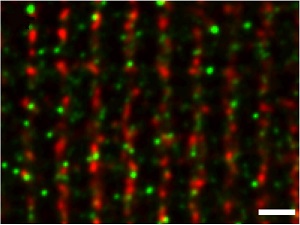Overview
- GST fusion protein with the sequence MLRALVQPATPAYQPLPSHLSAETESTCKGTVVHEAQLNHFYISPG, corresponding to amino acid residues 1-46 of rabbit CaV1.2a, with serine 44 replaced with alanine (Accession P15381). Intracellular, N-terminus.

 Western blot analysis of rat heart membranes:1. Anti-CaV1.2a (CACNA1C) Antibody (#ACC-013), (1:200).
Western blot analysis of rat heart membranes:1. Anti-CaV1.2a (CACNA1C) Antibody (#ACC-013), (1:200).
2. Anti-CaV1.2a (CACNA1C) Antibody, preincubated with Cav1.2a/CACNA1C Blocking Peptide (#BLP-CC013).
- Mouse brain homogenates (5 µg), (Garau, G. et al. (2015) Exp. Neurol. 274, 156.)
 Expression of CaV1.2a in rat heartImmunohistochemical staining of rat heart with Anti-CaV1.2a (CACNA1C) Antibody (#ACC-013). CaV1.2a was visualized with immuno-peroxidase methods and final brown-black diaminobenzidine color product (arrows in A). Cresyl violet is used as the counterstain. When the antibody was pre-incubated with the control peptide antigen, staining was blocked (B).
Expression of CaV1.2a in rat heartImmunohistochemical staining of rat heart with Anti-CaV1.2a (CACNA1C) Antibody (#ACC-013). CaV1.2a was visualized with immuno-peroxidase methods and final brown-black diaminobenzidine color product (arrows in A). Cresyl violet is used as the counterstain. When the antibody was pre-incubated with the control peptide antigen, staining was blocked (B).- Human cardiac tissue (Crossman, D.J. et al. (2011) PLoS ONE 6, e17901.).
- c-kit+ cells from mouse bone marrow (Lagostena, L. et al. (2005) Cardiovasc. Res. 66, 482.).
- Catterall, W.A. et al. (2003) Pharmacol. Rev. 55, 579.
- IUPHAR
- Hu, X.Q. et al. (1998) J. Biol. Chem. 273, 5337.
- Kreuzberg, U. et al. (2000) Am J. Physiol. 278, H723.
- Allard, B. et al. (2000) J. Biol. Chem. 275, 25556.
- Keef, K.D. et al. (2001) Am. J. Physiol. 281, C1743.
All L-type calcium channels are encoded by one of the CaV1 channel genes. These channels play a major role as a Ca2+ entry pathway in skeletal, cardiac and smooth muscles as well as in neurons, endocrine cells and possibly in non-excitable cells such as hematopoetic and epithelial cells. All CaV1 channels are influenced by dihydropyridines (DHP) and are also referred to as DHP receptors.
While the CaV1.1 and CaV1.4 isoforms are expressed in restricted tissues (skeletal muscle and retina, respectively), the expression of CaV1.2 is ubiquitous and CaV1.3 channels are found in the heart, brain and pancreas. Several peptidyl toxins are described that are specific L-type channel blockers, but so far no selective blocker for one of the CaV1 isoforms have been described. These include the Mamba toxins Calcicludine (#SPC-650), Calciseptine (#C-500) and FS-2 (#F-700).
There are two splice variants to the CaV1.2 channel designated CaV1.2a and CaV1.2b. The expression of the CaV1.2b variant is restricted to smooth muscle while CaV1.2a is specifically expressed in cardiac muscle.
Application key:
Species reactivity key:
Alomone Labs is pleased to offer a highly specific antibody directed against an epitope of rabbit CaV1.2a channel. Anti-CaV1.2a (CACNA1C) Antibody (#ACC-013) can be used in western blot, immunohistochemistry and immunocytochemistry applications. It has been designed to recognize CaV1.2a from mouse, rat and human samples.

Expression of CaV1.2 in human heart.Immunohistochemical staining of human heart sections using Anti-CaV1.2a (CACNA1C) Antibody (#ACC-013). CaV1.2 staining (green) shows moderate co-localization with ryanodine receptor staining (red).Adapted from Crossman, D.J. et al. (2011) PLoS ONE 6, e17901. with permission of PLoS.
Applications
Citations
- Transfected CHO-K1 cells.
Garau, G. et al. (2015) Exp. Neurol. 274, 156.
- Mouse brain homogenates (5 µg).
Garau, G. et al. (2015) Exp. Neurol. 274, 156.
- Human cardiac tissue.
Crossman, D.J. et al. (2011) PLoS ONE 6, e17901.
- c-kit+ cells from mouse bone marrow.
Lagostena, L. et al. (2005) Cardiovasc. Res. 66, 482.
- Wang, X.T. et al. (2000) Am. J. Pathol. 157, 1549.
- Shistik E. et al. (1999) J. Biol. Chem. 274, 31145.
